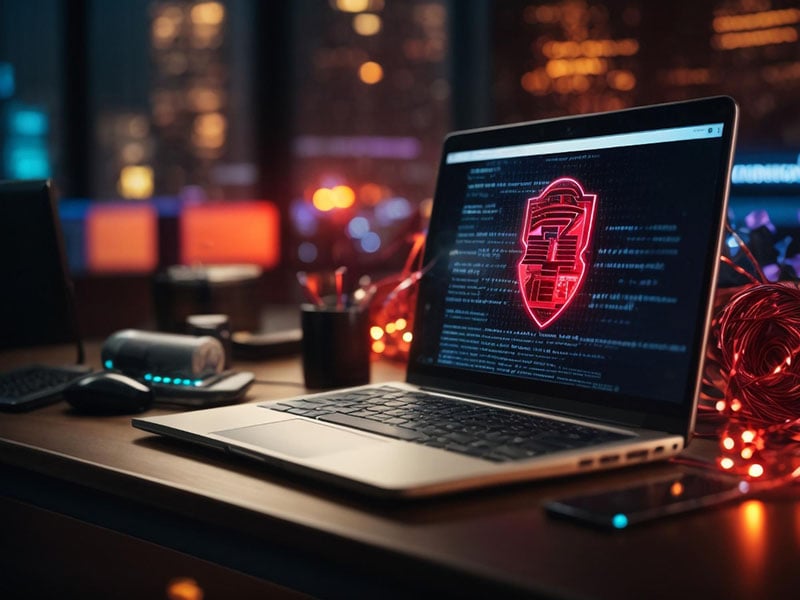A new FakeUpdates campaign targeting WordPress sites has been detected
20/03/2024Over the past few weeks, a new wave of the FakeUpdates malware, also known as SocGholish, has been detected, aimed at WordPress websites. The objective is to lure users into downloading remote access trojans, allowing attackers to take control of their systems. Since its emergence in 2017, FakeUpdates has been one of the most recurring malicious software in the cyber threat landscape. It has previously been associated with cybercriminal groups like Evil Corp, who monetize its use by selling access to infected systems. In this new campaign, cybercriminals are using JavaScript to target WordPress web pages, compromising compromised administrator accounts to introduce altered versions of WordPress plugins. These adulterated versions deceive users into downloading remote access trojans, granting attackers full control over infected devices. What is the most popular type of malware? In addition to the FakeUpdates attack, the threat index from Check Point Research, whose researchers have warned about this new attack, reveals around 200 suspicious content websites directed by ransomware groups. They utilize double extortion tactics to pressure victims into paying immediate ransoms. These attacks have impacted many companies, with the Lockbit3 ransomware being the most utilized by cybercriminals, followed by Play and 8base. The most exploited vulnerabilities by malicious actors include 'Web Servers Malicious URL Directory Traversal,' 'Command Injection Over HTTP,' and 'Zyxel ZyWALL Command Injection,' affecting numerous companies worldwide and allowing attackers to access and manipulate files or execute commands on compromised systems. In Spain, despite a 7% decrease in malware attacks in February, the most sought-after malware includes FakeUpdates, Qbot, and Pandora. In the case of FakeUpdates, it has affected 11.9% of companies in Spain. Mobile Malware In the realm of mobile devices, Anubis remains the most utilized malware in Spain, followed by AhMyth and Hiddad, all designed to compromise the security and privacy of Android device users by collecting confidential information and executing malicious actions.
[ ... ]
Privacy Policy
Esta política de privacidad aplica a todos los contenidos de este sitio web y que sean publicados por Dommia Design Studio. Si usted tiene alguna consulta sobre cómo usamos su información personal, por favor contacte con nuestro responsable de privacidad en [email protected]. Según lo establecido en el RGPD (Reglamento (UE) 2016/679), les proporcionamos la Información Detallada de Protección de Datos que se expone a continuación: Responsable: Dommia Design StudioRazón Social: Dommia Design Studio SLC.I.F.: B-66440581Dirección: c/ Lepant, 326, Entlo, Desp 3 - 08025 - BarcelonaTeléfono: 936 241 455Correo Electrónico: [email protected] Inscrita en el Registro Mercantil de Barcelona Tomo: 44619, Folio: 176, Hoja: 461387, Inscripción: 1 Información que recopilamos y con qué objetivo Esta sección detalla la información que podemos recoger sobre usted. Explicamos por qué y cómo lo utilizamos en secciones posteriores. Información que obtenemos a través de cookies y herramientas similares Utilizamos cookies (y tecnologías similares) y herramientas de análisis en nuestros sitios para recopilar información sobre usted. Esta información se puede utilizar para mejorar el rendimiento del sitio y mejorar la experiencia de usuario. Proporcionamos información detallada sobre cookies y tecnologías similares dentro de nuestra Política de Privacidad; algunos ejemplos incluyen: Su ubicación: utilizamos cookies para mostrar información del lugar más relevante para su ubicación. Su uso: utilizamos cookies para entender como nuestros clientes utilizan nuestros sitios. El dispositivo: utilizamos cookies para entender el tipo de dispositivo que está utilizando para mostrarle la mejor versión del sitio. Si desea administrar sus cookies, siga las instrucciones de la sección "Cómo gestionar las cookies" dentro de nuestra Política de Privacidad. Información que obtenemos a través del formulario de contacto Datos de contacto: nombre y correo electrónico. Web Beacons Utilizamos web beacon en nuestras páginas web y nuestros correos electrónicos. Cuando enviamos correos electrónicos a los miembros del boletín de noticias, podemos hacer un seguimiento del comportamiento como quien abrió los correos electrónicos y quien hizo clic en los enlaces. Esto nos permite medir el rendimiento de nuestras campañas de correo electrónico y mejorar nuestras características para determinados segmentos de miembros. Fundamentos legales para el procesamiento Solo tratamos información personal cuando tenemos su consentimiento de usuario: es decir, cuando nos ha dado permiso explícito para procesar información personal para un fin determinado. Por ejemplo, si completa uno de nuestros formularios de comunicación, le solicitaremos su consentimiento si quisiéramos utilizar su información personal para cualquier otro propósito. Usted tiene el derecho de retirar este consentimiento en cualquier momento. Puede administrar sus preferencias contactando con nuestro Delegado de Protección de Datos en [email protected]. ¿Cómo utilizamos su información personal? Recopilamos información personal por una razón principal, para mejorar y mantener el rendimiento de nuestro sitio web y poder brindarle la mejor experiencia de usuario posible. Recopilamos información personal por dos motivos principales: Mejorar y mantener el rendimiento: para proporcionarle la mejor experiencia de usuario posible, debemos asegurarnos de que nuestros productos y servicios funcionan como deberían ser. Comunicar cambios y ofertas de productos: queremos que obtenga el máximo rendimiento de nuestros productos o servicios, incluyendo mostrar nuestros últimos contenidos y boletines informativos. Puede cambiar sus preferencias en cualquier momento contactando a nuestro oficial de privacidad a [email protected]. ¿Con quién compartimos su información personal? No divulgamos su información personal a ningún tercero a menos que lo exijan las leyes aplicables, órdenes judiciales u otros procesos legales válidos. ¿Cuánto tiempo conservamos su información personal? Un resumen de la duración de su información personal: Categoría de datosEjemploPeríodo RetenciónJustificación del Período Comercial Clientes Hasta 5 años después de la resolución de cualquier relación comercial Para informar de nuestros productos y servicios Comercial Formulario de contacto Hasta 5 años después de la resolución de cualquier relación comercial Para informar de las peticiones realizadas por el usuario Marketing Newsletter Hasta que exprese su negativa a que sea enviada Para informar de nuestros productos y servicios Los datos se almacenarán el tiempo estrictamente necesario exclusivamente para el desempeño de sus competencias legalmente establecidas. A veces es necesario que guardemos su información personal por períodos más largos, por ejemplo: Si existe un requisito legal para retenerlo; Si requerimos la información por razones legales o existe una necesidad legítima para que la retengamos; Para garantizar que no nos comuniquemos con usted si nos ha pedido que no lo hagamos. ¿Cómo mantenemos su información personal segura? Contamos con las medidas de seguridad técnicas y organizativas adecuadas para garantizar que la información de nuestros usuarios esté protegida contra el acceso, uso, alteración o pérdida no autorizados o accidentales. Sus derechos Según las leyes de protección de datos, tiene derechos en relación con sus datos personales que gestionamos. Estos derechos incluyen: El derecho de oposición al márquetin directo; El derecho de acceso a los datos personales que procesamos sobre usted; El derecho a solicitar la eliminación de sus datos personales; El derecho a solicitar la rectificación de sus datos personales. Puede ejercer estos derechos contactando a nuestro oficial de Privacidad en [email protected]. ¿Dónde se aplica esta política de privacidad? La información personal recopilada por el CLIENTE. Nuestro sitio web puede contener enlaces a sitios web de terceros que no están sujetos a esta política de privacidad. No somos responsables de su contenido, uso de información personal o prácticas de seguridad. Si tiene una consulta sobre el tratamiento de su información personal, comuníquese con nuestro oficial de Privacidad en [email protected]. Cambios en esta política de privacidad Esta política es efectiva desde el 24/05/2018. Cualquier cambio que hagamos a esta política de privacidad se publicará en esta página, explicitando la fecha del último cambio.
[ ... ]WiFi Security: Assessment of threats in wireless networks
08/03/2024Wifi connectivity has gone from being limited to restricted environments to becoming omnipresent in virtually every aspect of our daily lives. The ability to connect to the Internet from anywhere, be it at home, in a café, at work, in public spaces, or even in-flight, has enhanced the convenience in our daily lives. Moreover, the expansion of Wifi networks and the use of new manufacturing technologies now allow the interconnection of devices, leading to the significant rise of the Internet of Things (IoT) and providing users with more comprehensive control over their digital environments. However, this proliferation of Wifi networks has also given rise to new threats that require careful evaluation and effective security strategies to ensure secure and risk-free Wifi connections for our data and information. Common Wifi security threats include data interception Man-in-the-Middle (MITM) attacks One of the fundamental challenges in Wifi security is preventing MITM attacks, where an intruder inserts themselves into the communication between two parties, compromising the integrity and confidentiality of sensitive data such as passwords and financial information. Spoofing of access points Hackers can create fake Wifi networks that mimic legitimate ones to attract unsuspecting users. Once connected to these malicious networks, our data can be captured by cybercriminals who may sell or misuse it for illicit purposes. Tips for achieving a secure Wifi connection: Strengthen authentication and use security protocols Prioritize strong encryption for networks to protect confidential information transmitted through it. WPA (Wifi Protected Access) encryption uses stronger algorithms than its predecessor, WEP (Wired Equivalent Privacy), making it more difficult for hackers to intercept and decipher data. Advanced security protocols like WPA3 provide individualized data encryption and advanced two-factor authentication (2FA) methods, adding an extra layer of security by requiring additional verification. Device management Properly manage and monitor devices connected to Wifi networks to minimize risks associated with the large number of connected devices in homes and businesses. Regularly update the router firmware and all connected devices to address potential vulnerabilities. Segmentation of the network to separate critical devices from less secure ones also helps mitigate the risk of threat propagation. Secure Router Configuration The router secure configuration is what will ensure the robustness and overall security of a wireless network. The router, being the first point of contact for devices connected to the Internet, acts as the first line of defence against potential attacks. For this reason, it is important to understand that the proper configuration of the router not only guarantees a stable and efficient connection but also establishes a protected environment that safeguards the integrity and privacy of our data. How to configure the router securely? To ensure a correct and secure configuration of the router, it is recommended to: Change the default username and password of the router, as these are easily accessible to attackers. Use strong passwords containing a combination of letters, numbers, and special characters. Disable remote administration to prevent cybercriminals from accessing the router externally. Enable WPA2 or WPA3 encryption instead of the outdated WEP for enhanced network security. Optionally, disable SSID broadcast to make the network less visible and harder to detect by hackers. Keep the router firmware updated to address vulnerabilities and improve overall device security. By following these steps, you will strengthen the security of your wireless network and reduce the chances of experiencing unwanted attacks or intrusions.
[ ... ]Where to watch the Champions League on TV or Streaming?
13/06/2023Find out where you can watch the Champions League so as not to miss a minute of this excellent competition that this year again promises good soccer and maximum excitement. When does the Champions League 2021/2022 start? The UEFA Champions League Group Stage starts in mid-September. The first match day will be played on Tuesday, September 14, and will feature Sevilla, who will face RB Salzburg in the Andalusian capital; Villarreal, who will play at home against Atalanta; and FC Barcelona, who will face Bayern Munich, also at home. The following day, on September 15, the 2021/2022 Champions League will kick off for Atlético de Madrid, who will play against Porto at the Wanda Metropolitano, and also for Real Madrid, who will play their first match against Inter, in Milan. This first Group Stage will have six matchdays in which the 32 teams participating in this edition of the Champions League will face each other in home and away matches that you will be able to follow both on television and streaming. Group stage September 14/15, 2021: first matchday September 28/29, 2021: second matchday October 19/20, 2021: third matchday 2/3 November 2021: fourth matchday November 23/24, 2021: fifth matchday December 7/8, 2021: sixth matchday Once the six matchdays of the group stage have been completed, the competition will continue with the knockout phase, which will determine the two teams that will play in the UEFA Champions League final. Knockout Phase Round of 16: February 15/16/22/23 and March 8/9/15/16/16, 2022 Quarter-finals: 5/6 and 12/13 April 2022 Semifinals: May 26/27 and 3/4, 2022 Where to watch the Champions League on TV? As with LaLiga Santander and Liga SmartBank, Movistar has exclusive rights to the UEFA Champions League in Spain until 2024. However, following an agreement with Orange, Movistar has decided to share the rights with this operator, so that in Spain this season the Champions League can be watched on TV on Movistar and Orange TV. In both cases, the broadcasting of the UEFA Champions League group stage matches as well as those of the knockout phase and the Final will be included. How to watch the Champions League on Orange TV? Although Orange does not have direct rights to the Champions League in Spain, its agreement with Movistar allows its customers to watch live Champions League matches on Orange TV. These broadcasts are exclusively for the operator's customers who have the Orange Love Total package, which includes the UEFA Champions League, Liga Santander, and Liga SmartBank matches, in addition to the UEFA Champions League. How to watch the Champions League on Movistar? To watch the Champions League on Movistar we must be customers of this operator and have contracted the Fusión Selección Champions or Fusión Selección Plus con Fútbol package, which also includes the Liga Santander and Liga SmartBank matches. If our package is Fusión Selección con LaLiga, we will only have access to the Spanish football competition and we will not be able to watch the Champions League matches. The Movistar channel on which the Champions League can be watched is called " Movistar Liga de Campeones". "Movistar Liga de Campeones" is an exclusive TV channel for watching soccer and in addition to the UEFA Champions League, it also provides coverage of the Europa League.The schedules of all broadcasts can be consulted in the Sports section of the Movistar+ menu, for ADSL and Fiber TV customers. Where can I watch the Champions League live on the Internet? Both Movistar and Orange complete their Champions League soccer offer on TV through their online platforms. In both cases, to enjoy soccer on our mobile devices or computer, we must be subscribed to a package that includes the UEFA Champions League (in Movistar, Fusión Selección Champions or Fusión Selección Plus con Fútbol, and in Orange TV, Love Total). If you are a Movistar customer and have one of these packages, you must activate Movistar+ on your devices (formerly Yomvi) and you will have access to watch the Champions League online matches on Movistar as well as other online content and series, at no additional cost from anywhere and on any device. All broadcast schedules can be consulted in the Sports section of the Movistar+ menu on any device. To watch the Champions League online on Orange, you must log in to the Orange TV website to identify yourself as a Love Total member. Once we have logged in, we will be able to watch live matches of the UEFA Champions League, LaLiga Santander, LaLiga SmartBank, and also watch matches that have already taken place. Where can I watch the Champions League from outside Spain? If you are a Movistar or Orange customer, the best option to watch the Champions League from abroad is through Movistar+ on your devices or the online platform of Orange TV. If you have problems viewing the matches due to a geographical block, the best option, in this case, is to connect to a VPN with a Spanish IP beforehand. If your Internet access provider does not offer this service, here are the best VPN offers to surf safely (both from home and when traveling). In addition, and depending on the country you are in, various television stations and operators have the broadcasting rights to the UEFA Champions League: Europe Albania: Tring, RTSH Armenia: Vivaro Austria: ServusTV, Sky Austria Azerbaijan: CBC Sport, Saran Belarus: UEFA.tv Belgium: Proximus, RTL, VTM Bosnia and Herzegovina: Arena Sport Bulgaria: A1, bTV Croatia: HRT, Arena Sport Cyprus: CYTA Czech Republic: Nova, Voyo Denmark: NENT Group Estonia: Viaplay Finland: MTV France: Canal+, BeIN Georgia: Adjara, Silknet Germany, DAZN Greece: MEGA, COSMOTE TV Hungary: Sport1, MTVA Iceland: Viaplay, Syn Republic of Ireland: Livescore, Virgin Media, RTE Israel: The Sports Channel Italy: Amazon, Mediaset, Sky Italia Kazakhstan: QazSport, Q Sport League, Saran Kosovo: Arena Sport, Artmotion Kyrgyzstan: Saran, Q Sport Latvia: Viaplay Lithuania: Viaplay Luxembourg: RTL, Proximus Malta: Melita, PBS Moldova: Setanta, Prime Montenegro: Arena Sport Netherlands: RTL, Ziggo Sport North Macedonia: Makedonski Telekom, Arena Sport, MTV Norway: TV2 Norway Poland: Polsat Portugal:Eleven Romenia: Clever Media, Digisport, Telekom Romania Russia: Match TV Serbia: Arena Sport Slovakia: Markiza, Voyo Slovenia: Sportklub, Pro Plus Spain: Telefonica, Orange TV Sweden: Telia Switzerland: blue+, CH Media Tajikistan: Varzish TV, Saran Turkey: EXXEN Turkmenistan: Saran Ukraine: Megogo UK: BT Sport Uzbekistan: MTRK Africa and Middle East Nigeria: SuperSport South Africa: SuperSport Middle East and North Africa (Algeria, Bahrain, Chad, Djibouti, Egypt, Iran, Iraq, Jordan, Kuwait, Lebanon, Libya, Morocco, Oman, Qatar, Saudi Arabia, Sudan, Syria, Tunisia, United Arab Emirates, Yemen): beIN Sub-Saharian Africa: Canal+, SuperSport America Bolivia: Televideo Brazil: SBT, Turner Canada: DAZN Caribbean: Flow Sports, Sportsmax Central America: ESPN Costa Rica: Teletica Dominican Republic: Televideo Ecuador: Televideo El Salvador:Canal Dos Guatemala: Televideo Haití: Canal+ Honduras: Televicentro South America (except Brazil): ESPN Mexico: Turner Panama: TVN, Medcom Paraguay: Televideo Peru: Televideo United States: CBS, TUDN Deportes Venezuela: La Tele Tuya Asia and Pacífic Australia: STAN Brunei: beIn Cambodia: beIn China PR: PPTV, Tencent, iQIYI, Alibaba Hong Kong SAR: beIn India and Indian subcontinent: Sony Indonesia: SCTV Japan: Wowow Republic of Korea: SPO TV Laos: beIn Macau SAR: TDM Malaysia: beIn Mongolia: SPS Myanmar: TBA New Zealand: Spark Pacific Islands: Digicel Philipines: Tap TV Singapore: beIn Taiwan/Chines Taipei: Elta Thailand: beIn Vietnam: FPT Moreover, if you are one of those who can't miss a single live match, you should know that the Sport24 platform has the rights to broadcast Champions League matches on airplanes and cruise ships. Where to watch the final match of the Champions League 2021/2022? The 2021/2022 Champions League final will be held at the Gazprom Arena in St. Petersburg, Russia, on May 28, 2022. Like the rest of the competition, you can watch the Champions League final on TV through Movistar-Movistar Liga de Campeones dial 50 and Orange TV. Where to watch the Champions League 2021/2022 final on the Internet? In addition to television, you can also watch the Champions League final online. In this case, you must also be a Movistar or Orange customer and connect to Movistar+ on devices (former Yomvi) in the first case or to the online platform of Orange TV, if you are an Orange customer to enjoy the match in which the best European soccer team 2021/2022 will be proclaimed. How can I watch LaLiga soccer matches from abroad? If you have already contracted a television service with the LaLiga package and due to a geographic blocking of your television provider and your connection you have problems viewing the matches, the best option, in this case, will be to use a VPN that assigns you an associated IP that is not blocked. If your Internet access provider does not offer this service, below are the best VPN offers to surf safely from anywhere.
[ ... ]Macro cyber-attack affects more than 350 companies worldwide
07/07/2021The number of companies that have suffered from the REvil macro cyberattack now exceeds 350 organizations worldwide from which the cybercriminals are demanding 70 million in bitcoins to provide them with a universal decryptor to restore their data. The attack was conducted through the update system of IT services software company Kaseya, which REvil exploited to spread and hide ransomware. The virus was leaked to TI Kaseya resellers and from there has reached all end customers using their software. The official data provided by TI Kaseya sets the number of affected companies at 350, although other sources such as the cybersecurity company ESET talk about more than 1,000, including some Spanish organizations, although no names have been disclosed. It has been made public that one of the companies most affected by the cyberattack has been the Swedish supermarket chain Coop, which has had to close its more than 800 points of sale for a few days due to the impossibility of using its cash registers or charging customers. Based on Sophos threat intelligence, REvil has been active in recent weeks and is currently the dominant ransomware gang involved in Sophos' defensively managed threat response cases. Prior to this latest attack, they were also responsible for the one suffered by meat company JBS, which forced the cancellation of all work shifts at the company's slaughterhouses in the US. JBS paid up to 11 million to restore normal operations. These macro cyber-attacks are in addition to other recent and highly significant ones, such as the one perpetrated by the hacker group DarkSide, which forced the preventive shutdown of the largest oil pipeline network in the United States, Colonial Pipeline, endangering the supply of fuel in a large part of the country, or the one suffered by the SEPE and the Ministry of Labor in Spain a few weeks ago.
[ ... ]How to sign a PDF document with electronic signature?
24/06/2021When a document needs to be signed by one or more people, the usual thing, until now, has been to print it and stamp by hand the necessary signatures to validate or make its content official. This requires paper, printer, ink, but above all access to the document by all signatories, which is not always easy due to geographical location, availability, timing, etc. With teleworking on the rise and a growing globalization of business, these drawbacks have become more evident than ever, although they have found a quick and effective solution in electronic signatures. What is an electronic signature for? The electronic signature is a digital validation system for documents that unequivocally identifies the signatory. The electronic signature is assimilated to the handwritten signature and therefore its digital stamping on a document gives it the same validity, as it would have had with a handwritten signature. What are the advantages of electronic signatures? Electronic signatures simplify document management processes that require the validation of documents such as pdf signatures, facilitating remote signing by one or more people regardless of where they are located, or the situation or time of day they receive them. This flexibility contributes to the efficiency and agility of this type of procedure and being a secure signature system, it is suitable and useful in many areas related to business management, administrative management, e-commerce, informed consent and many other procedures. In addition to the versatility, practicality and security of the online PDF signature, we must also point out, as a great advantage of this process, its contribution to paperless. How to sign electronically? The electronic signature is easy to implement through tools specifically designed to guarantee not only the correct validation of the cryptographic signature or signatures included in a PDF document, but also that it cannot be altered and that all the necessary signatures required by each situation can be added. Within the framework of this type of tool, the most advanced ones, in addition to being compatible with any browser and accessible from any type of device - computer, tablet, Smartphone,... -, make it easy to convert PDF any Word, Excel, JPG, PowerPoint... file for signing. They also allow users to request a verifiable digital signature, view the properties of the digital signature and send the document directly by email to the signatories and once signed, forward it to all parties to download it. In addition, to guarantee the privacy of the documents and the security of the online signatures, these transfers are made through encrypted files with TLS encryption. Also, when we sign documents using this type of tool, they offer the option of including a LTV (Long Term Validation) time stamp that certifies the validity of the signature in the long term. For all these reasons, tools for signing PDF documents with electronic signatures are now a must for companies and businesses in all areas where process optimization, security and sustainability are a priority.
[ ... ]How to set up a digital marketing strategy?
16/06/2021As our daily life Internet gains prominence in our physical world, companies selling products and services are increasing their online presence. To do so, they resort to strategies and tactics that ensure their omnipresence in both worlds, with the main task of attracting and retaining customers who buy their products. In this race for customers' attention, strategies such as Inbound Marketing and Outbound Marketing have emerged as protagonists and although they are radically different in their forms, both techniques have found in online communication an ideal medium through which to achieve their goals. What is Inbound Marketing? Inbound Marketing is based on attracting customers through non-intrusive techniques that use content related to the needs and interests of our target audience to attract them to our brand and products. Inbound Marketing Strategy In Inbound Marketing, content is the king and the strategy to get the user to approach the brand is to create, through these contents, links with the customer and establish a relationship of trust and support that favors their interest in our products and services, as well as their loyalty. To achieve this attention on the contents, it is basic and essential to optimize the SEO search engine, which makes our website, our contents and brand visible, makes us relevant and also contributes to our authority. To achieve this optimization and positioning, SEO will be in charge of indicating which words are trending in searches related to our content, will improve the structure of the web to allow a correct user experience, will implement a good strategy of referral links or link building and will take care of other aspects such as the integration of CRM tools or user metrics. All this will make it possible for our content to be positioned and that in a totally "natural" way and without any intrusion, all those contents written according to the interests of a certain group of customers, awaken their interest and attract them to our brand. Inbound Marketing Tools Throughout the whole process of customer attraction and loyalty, the Inbound Marketing strategy has a wide variety of tools to achieve its goal: Blogs Landing page Lead Creation Calls to action Intelligent content Workflows, ... What is outbound Marketing? Unlike Inbound Marketing, outbound Marketing is based on a totally traditional commercial approach, in which the product or service being sold is the only protagonist of the communication. Outbound Marketing Strategy To reach the public, outbound strategies use invasive methods that address broad audiences, without a specific target, with the intention of reaching the maximum number of possible interested parties. Outbound Marketing strategies are based on one-way communication, from the brand to the customer. The company shows the value of its products and services and tries to convince the public to buy them. All this operation is implemented without the customer's request, even before he has made a search or has shown previous interest in a specific product or service. Outbound Marketing Tools In Outbound Marketing, since there is no specific target audience segment, the communication reaches many users, although it may not be of interest to any of them. To achieve this massive distribution, companies use resources such as: Pop-ups Advertisements inserted in videos Banners Email campaigns for which companies use powerful email marketing software in Spanish, with multiple integrated tools that allow from automating mass mailings to A/B testing, comprehensive monitoring of the actions of each recipient (open rate, clicks on links,...) or even advanced segmentation based on interactions and / or user behavior detected in previous actions. Newsletter, inbound or outbound marketing? Now that we know the differences between Inbound and Outbound Marketing, we will finish by looking at a very useful and versatile tool that, unlike those previously mentioned is used interchangeably by both strategies. We are referring to the Newsletters. If we look at the Newsletter of Which is my IP, for example, we would be talking about an Inbound strategy, because to receive the electronic newsletter you must first register (by the way, if you have not done so yet, do not miss it and you will receive timely information on news and updates to get the most out of your Internet connection). On the other hand, if we look at newsletters like the ones we have all surely received at some time, in which we are offered, for example, a telephone offer from a company that is not our own, we are dealing with an electronic newsletter included in the marketing plan of an Outbound strategy. At this point, we can only conclude that knowing our priorities as a company, analyzing the degree of knowledge we have about our target and assessing our objectives, we will have all the necessary answers to start working and designing our digital marketing strategy.
[ ... ]QUIC, the new official network protocol to replace TCP
04/06/2021QUIC, the network protocol designed by Google, has been presented by the Internet Engineering Task Force, IETF, as a new official Internet standard to replace TCP, the current main standard. Google's QUIC (Quick UDP Internet Connections) network protocol is designed to reduce latency with retransmissions taking less time, potentially reducing the waiting time for search results by 8% on computers and 4% on mobile devices, according to the paper released by Google in 2017. QUIC will replace TCP, the current main standard of the Internet since 1974 - when it was still Arpanet - and on which the operation of Internet elements such as the World Wide Web (WWW) logic system, file transmission, 'emails' and remote administration depend. The new QUIC protocol has already been published by the IETF, making it an official network protocol.
[ ... ]








